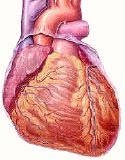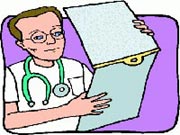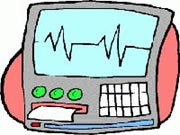| (insert your NIE or newspaper logo here) |
Weekly Online LessonOnline Lesson ArchiveGrade Level: 8-12
|
It Takes Heart
 Shortness of breath and chest pains persuaded former President Bill Clinton, 58, to visit his doctor earlier this month. And it's a good thing he did.
Shortness of breath and chest pains persuaded former President Bill Clinton, 58, to visit his doctor earlier this month. And it's a good thing he did.
Tests discovered that Clinton suffered from a type of heart disease. In his case, diseased blood vessels were making it hard for his heart to work properly.
Within a few days of his diagnosis, Clinton underwent a quadruple bypass operation. During surgery, healthy blood vessels were taken from his chest wall and a leg. These healthy vessels were then stitched in to his heart to bypass the diseased vessels.
On Wednesday, September 16, 2004, ten days after the operation, Clinton's wife, Hillary, reported to the press that he was recovering well. She noted that they were lucky to spot the warning signs early and get treatment before his condition got worse.
More than 23 million Americans -- about 11 percent of the population -- have been diagnosed with some type of heart disease. Some types affect blood vessels, while others affect the heart's valves or muscle. Hundreds of millions die from heart disease every year, ranking it the nation's number one killer.
Knowing how your heart works is a good place to start learning how to keep it healthy, so that's where you'll begin this week's lesson. Then you'll sign-up as an intern and work with a cardiologist to discover how doctors trace a patient's symptoms to diagnose his specific condition and choose an appropriate treatment.
Heart Basics
 Your first stop is at MEDtropolis to check out their Virtual Body (Flash Player required). Choose your language, then head straight for the Human Heart section.
Your first stop is at MEDtropolis to check out their Virtual Body (Flash Player required). Choose your language, then head straight for the Human Heart section.
Review the Heart Parts and watch the Animated Heart at work. What is the heart's primary purpose? Why does the heart contain two separate, nearly identical halves?
Now click to the Narrated Tour, with or without audio speakers.
How does the heart help get oxygen to different parts of the body? What roles do the heart's blood vessels and muscle tissue play in this cycle? What are the functions of the tricuspid and bicuspid valves? What exactly creates the sound of our heartbeat?
Now uncover the basics of Heart Disease. Read the General Overview, then explore that section in-depth or check out brief descriptions of a few primary heart problems: Arrythmias, Coronary Artery Disease, and Heart Attacks.
In what ways can a person's diet and exercise routine affect how well the heart functions? Can some heart problems be inherited?
The Doctor is IN
 Now you're ready to put your brief medical training into practice as an intern in the Howard Hughes Medical Institute's Virtual Lab.
Now you're ready to put your brief medical training into practice as an intern in the Howard Hughes Medical Institute's Virtual Lab.
Your job: Pinpoint each patient's specific heart condition...with a little help from the doctor, of course!
To begin, click the center image to Enter the lab and open an interactive pop-up window. Read the Intro, and follow the instructions in the left-hand side of the window.
You will first meet Patient A. As you examine the patient and analyze the symptoms, you are encouraged to use the Cardiology Guide and the Diagnostic Tools Guide to help you understand the medical terminology.
 Complete and submit each quiz to move on to the next step.
Complete and submit each quiz to move on to the next step.
Continue through Patient A's examination until you come to a diagnosis of his condition. Make similar office visits with Patient B and Patient C.
What exactly makes the lub and dub sounds of the heart? Why is listening to a patient's heartbeat a good place to begin the examination? How did performing different tests -- including the auscultation exam, echocardiography, MRI, and pedigree analysis -- help to diagnose a patient's condition? What kinds of factors influence the normal functioning of a person's heart? Which are controllable and which are not?
Newspaper Activities
Browse a current issue of Targetnewspaper, to find articles about cardiology or someone fighting or recovering from heart disease. Have there been any new advancements in detecting or treating one or more types of heart disease? Have researchers discovered any new evidence about what causes one or more types of heart disease? In what way is heart disease affecting patients? What about their families? How do the successes and failures of diagnosing and treating heart diseases help doctors and researchers come up with new or more effective methods?
© Copyright 2004
Learners
Online,
Inc.
